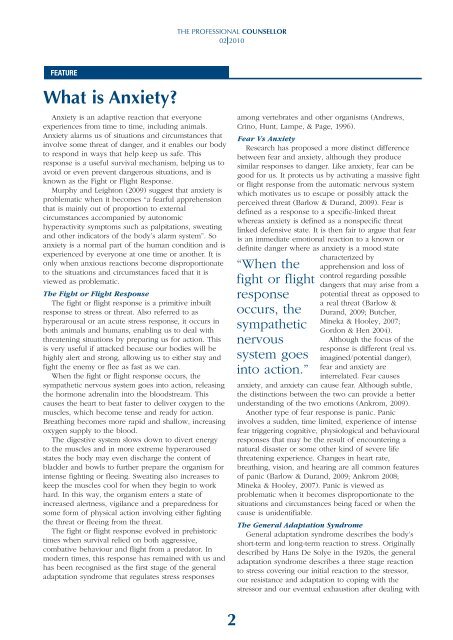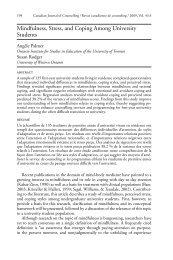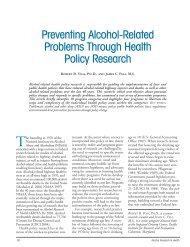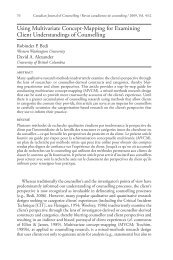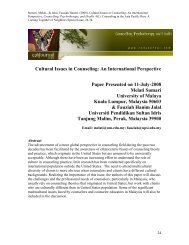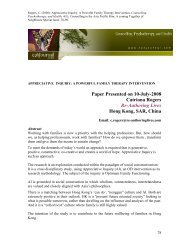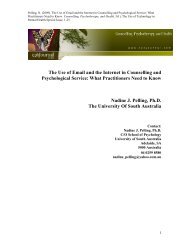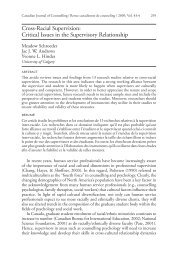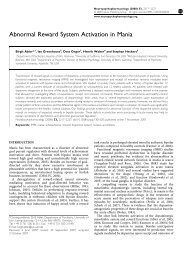PROFESSIONAL COUNSELLOR - Mental Health Academy
PROFESSIONAL COUNSELLOR - Mental Health Academy
PROFESSIONAL COUNSELLOR - Mental Health Academy
- No tags were found...
You also want an ePaper? Increase the reach of your titles
YUMPU automatically turns print PDFs into web optimized ePapers that Google loves.
THE <strong>PROFESSIONAL</strong> <strong>COUNSELLOR</strong>02 2010FEATUREWhat is Anxiety?Anxiety is an adaptive reaction that everyoneexperiences from time to time, including animals.Anxiety alarms us of situations and circumstances thatinvolve some threat of danger, and it enables our bodyto respond in ways that help keep us safe. Thisresponse is a useful survival mechanism, helping us toavoid or even prevent dangerous situations, and isknown as the Fight or Flight Response.Murphy and Leighton (2009) suggest that anxiety isproblematic when it becomes “a fearful apprehensionthat is mainly out of proportion to externalcircumstances accompanied by autonomichyperactivity symptoms such as palpitations, sweatingand other indicators of the body’s alarm system”. Soanxiety is a normal part of the human condition and isexperienced by everyone at one time or another. It isonly when anxious reactions become disproportionateto the situations and circumstances faced that it isviewed as problematic.The Fight or Flight ResponseThe fight or flight response is a primitive inbuiltresponse to stress or threat. Also referred to ashyperarousal or an acute stress response, it occurs inboth animals and humans, enabling us to deal withthreatening situations by preparing us for action. Thisis very useful if attacked because our bodies will behighly alert and strong, allowing us to either stay andfight the enemy or flee as fast as we can.When the fight or flight response occurs, thesympathetic nervous system goes into action, releasingthe hormone adrenalin into the bloodstream. Thiscauses the heart to beat faster to deliver oxygen to themuscles, which become tense and ready for action.Breathing becomes more rapid and shallow, increasingoxygen supply to the blood.The digestive system slows down to divert energyto the muscles and in more extreme hyperarousedstates the body may even discharge the content ofbladder and bowls to further prepare the organism forintense fighting or fleeing. Sweating also increases tokeep the muscles cool for when they begin to workhard. In this way, the organism enters a state ofincreased alertness, vigilance and a preparedness forsome form of physical action involving either fightingthe threat or fleeing from the threat.The fight or flight response evolved in prehistorictimes when survival relied on both aggressive,combative behaviour and flight from a predator. Inmodern times, this response has remained with us andhas been recognised as the first stage of the generaladaptation syndrome that regulates stress responsesamong vertebrates and other organisms (Andrews,Crino, Hunt, Lampe, & Page, 1996).Fear Vs AnxietyResearch has proposed a more distinct differencebetween fear and anxiety, although they producesimilar responses to danger. Like anxiety, fear can begood for us. It protects us by activating a massive fightor flight response from the automatic nervous systemwhich motivates us to escape or possibly attack theperceived threat (Barlow & Durand, 2009). Fear isdefined as a response to a specific-linked threatwhereas anxiety is defined as a nonspecific threatlinked defensive state. It is then fair to argue that fearis an immediate emotional reaction to a known ordefinite danger where as anxiety is a mood state“When thefight or flightresponseoccurs, thesympatheticnervoussystem goesinto action.”characterized byapprehension and loss ofcontrol regarding possibledangers that may arise from apotential threat as opposed toa real threat (Barlow &Durand, 2009; Butcher,Mineka & Hooley, 2007;Gordon & Hen 2004).Although the focus of theresponse is different (real vs.imagined/potential danger),fear and anxiety areinterrelated. Fear causesanxiety, and anxiety can cause fear. Although subtle,the distinctions between the two can provide a betterunderstanding of the two emotions (Ankrom, 2009).Another type of fear response is panic. Panicinvolves a sudden, time limited, experience of intensefear triggering cognitive, physiological and behaviouralresponses that may be the result of encountering anatural disaster or some other kind of severe lifethreatening experience. Changes in heart rate,breathing, vision, and hearing are all common featuresof panic (Barlow & Durand, 2009; Ankrom 2008;Mineka & Hooley, 2007). Panic is viewed asproblematic when it becomes disproportionate to thesituations and circumstances being faced or when thecause is unidentifiable.The General Adaptation SyndromeGeneral adaptation syndrome describes the body’sshort-term and long-term reaction to stress. Originallydescribed by Hans De Solye in the 1920s, the generaladaptation syndrome describes a three stage reactionto stress covering our initial reaction to the stressor,our resistance and adaptation to coping with thestressor and our eventual exhaustion after dealing with2


